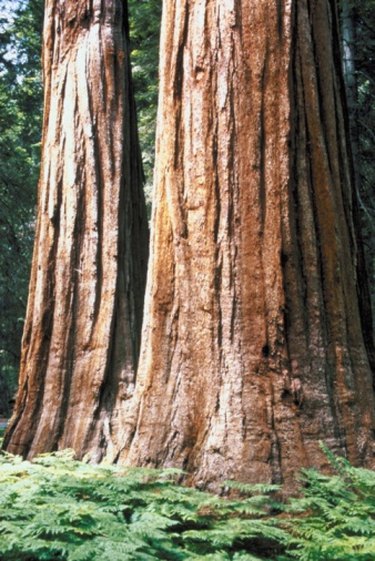
Sierra redwood, also known as the giant sequoia or Sequoiadendron giganteum, is considered the largest living organism on earth. This extremely tall tree is native to limited parts of California and is not currently used for lumber. However, giant sequoia trees were once logged. Items made from this wood are relatively rare and can be hard to tell from other redwood species. Like other sequoias, this tree is a moderately hard softwood.
Old Growth
Video of the Day
Old growth Sierra redwood trees are very large and have a hardness similar to that of old growth coastal redwood, at about 480 pounds-force on the Janka hardness scale. These trees would seem to be excellent lumber candidates due to their size but are actually very brittle, rendering them useful only for very small projects. This species has a specific gravity of 0.30 in old growth wood.
Video of the Day
Young Wood
Younger Sierra redwoods make better lumber than old growth trees. The wood is slightly softer but also considerably less brittle. Young giant sequoia trees have wood similar to that of coastal redwoods, rating at about 420 pounds-force on the Janka scale. According to the United States Department of Agriculture (USDA), young giant sequoia wood works well as veneers, plywood and dimensional lumber.
Historical Use
The Sierra redwood was cut commercially for lumber between the 1850s and 1950s, according to the USDA. This tree was considered a relatively undesirable softwood compared to the coastal redwood and other sequoia relatives due to its brittleness and the difficulty in felling the trees. According to the Auburn University Southern Forest Nursery Management Cooperative, giant sequoia trees tended to shatter when they hit the ground, resulting in the loss of up to 80 percent of the tree's volume. The large trees were also difficult to move and process, even if they survived the fall. Most Sierra redwood was used in shingles, shakes, fence posts, patio furniture and other applications where its rot-resistant qualities were beneficial.
Considerations
Despite their poor lumber properties, giant sequoia trees were logged extensively. According to the ARKive conservation organization, as much as 34 percent of the tree's native range was lost to timber harvesting before the tree was protected. Currently, most giant sequoias grow in park lands and are not subject to logging. The tree is considered vulnerable to extinction and exists primarily as a tourist attraction. However, some trees are deliberately grown in silviculture operations, which harvest the more desirable young wood.